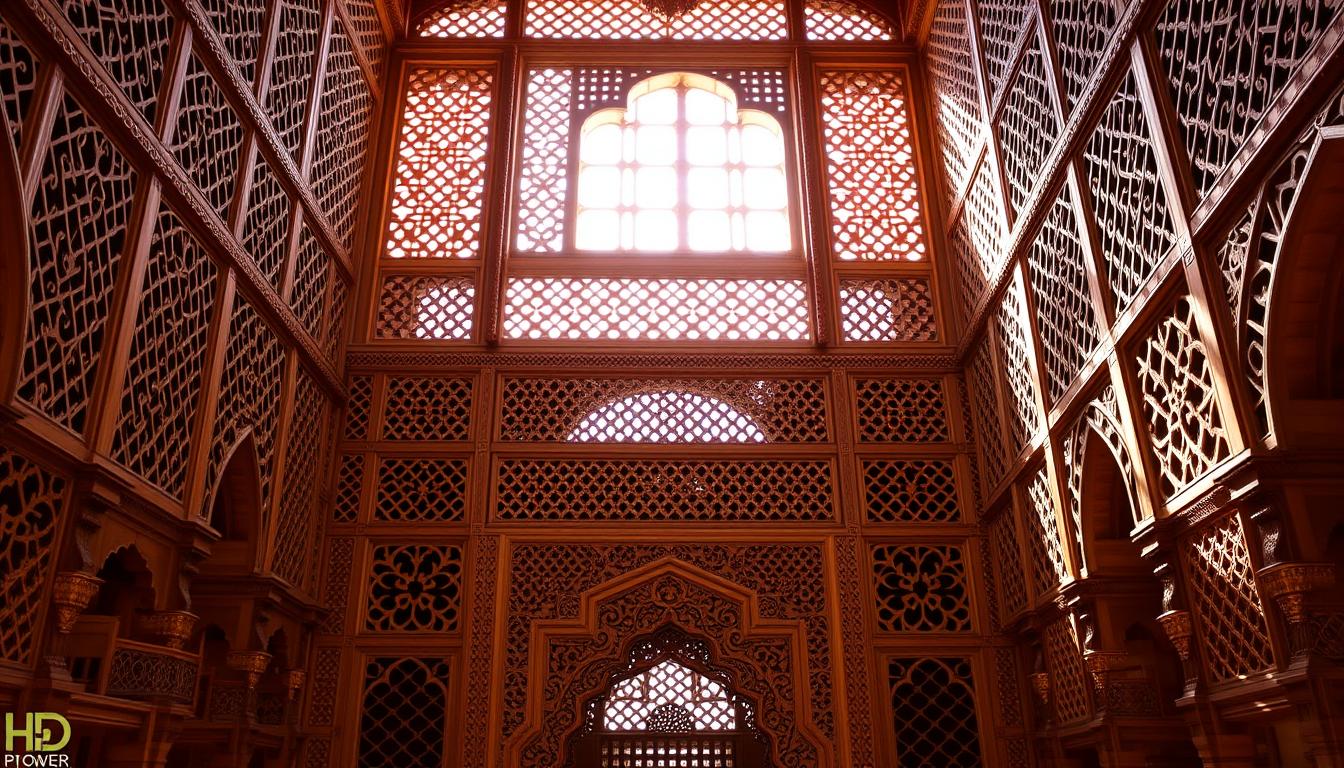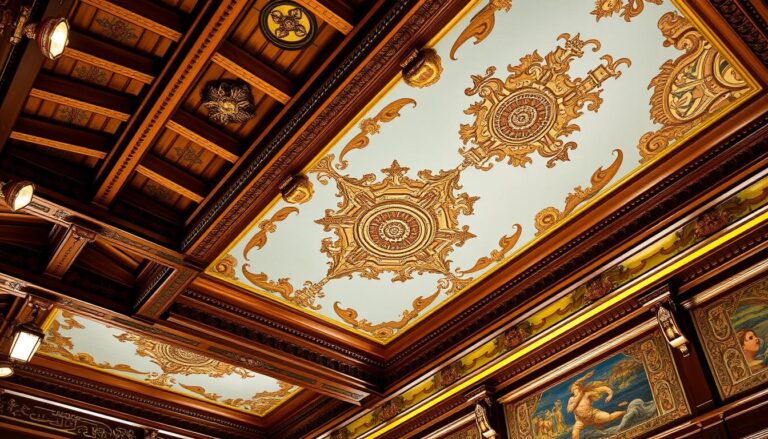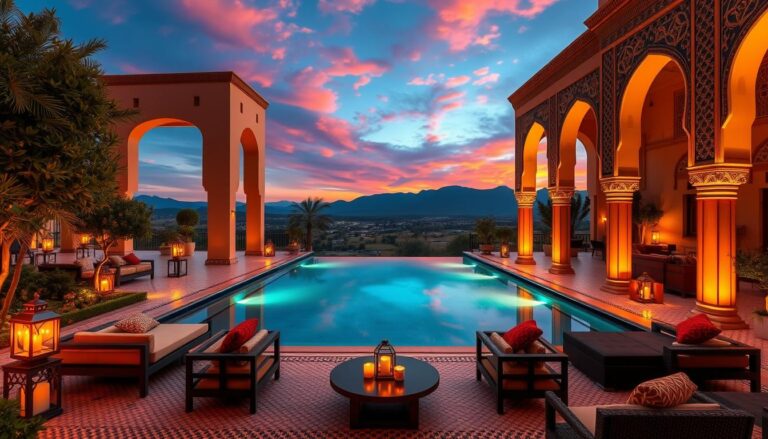When you enter the world of Moroccan architecture, you’re drawn to the stunning wooden lattices called mashrabiya. These screens, filled with intricate designs, have been a key part of Islamic architecture for ages. They have a special charm that continues to inspire artists and architects today.
Let’s dive into the beauty of mashrabiya’s patterns, the skill of Moroccan craftsmen, and its deep cultural meaning. We’ll see how this traditional woodcarving has left a lasting mark on Moroccan architecture.
Key Takeaways
- Mashrabiya, the traditional lattice-style wooden screens, have been a prominent feature in Moroccan and Islamic architecture for centuries.
- These intricate designs encompass a range of geometric patterns and showcase the exceptional craftsmanship of Moroccan artisans.
- Mashrabiya serve functional purposes, such as regulating airflow, providing shade, and maintaining privacy in traditional Middle Eastern homes.
- The mashrabiya is a symbol of Moroccan cultural heritage, with contemporary artists exploring its form and symbolism in their work.
- Preserving and reviving the art of mashrabiya-making is crucial in maintaining the architectural identity and artisanal traditions of Morocco.
Intricate Wooden Lattices: The Art of Mashrabiya
The mashrabiya, with its detailed wooden lattices, shows Morocco’s deep cultural roots and skill in crafts. These screens, famous for their shapes and designs, are key in Islamic architecture. They look good and serve a purpose.
Geometric Patterns and Craftsmanship
The mashrabiya’s designs come from Islamic art, showing unity and beauty. Moroccan woodworkers have perfected their craft over years. They work with cedar wood, making it smell nice and look amazing.
Cultural Heritage and Islamic Architecture
The mashrabiya is more than a pretty face; it shows Moroccan culture and Islamic architecture’s lasting impact. Its woodcarvings and patterns are seen across the Middle East. This shows the shared artistic history of the area.
The Moorish style also influenced European buildings, especially in Spain. This is seen in the mashrabiya’s unique features, like arches and tile work. These designs have inspired many designers around the world.
“The mashrabiya is not just a functional element, but a work of art that embodies the cultural and artistic identity of Morocco. It is a testament to the enduring legacy of Islamic architecture and the skilled craftsmanship of Moroccan artisans.”
The mashrabiya is a symbol of Moroccan culture and Islamic architecture’s tradition. Its beauty and craftsmanship continue to amaze people everywhere.
Traditional Woodcarving (Mashrabiya) in Moroccan Architecture
The mashrabiya is a key part of Moroccan architecture. These wooden lattices are known for their detailed patterns and skillful craftsmanship. They showcase the area’s rich cultural heritage and Islamic art.
The mashrabiya started in Baghdad in the 12th century. Over time, it has changed, showing the many artistic influences on Moroccan architecture. The name “mashrabiya” comes from Arabic, meaning “drinking” or “absorbing,” hinting at its role in cooling and humidifying air.
In Moroccan buildings, the mashrabiya does more than just cool the air. It also adds beauty, controls airflow, and creates interesting light and shadow patterns. Recently, there’s been a comeback in using this woodcarving technique in modern designs.
“The mashrabiya is a testament to the enduring artistry and innovation of Moroccan craftsmen, whose skill in woodworking has been honed over generations.”
The Museum for Art in Wood in Philadelphia has an exhibit called “The Mashrabiya Project: Seeing Through Space.” It showcases work by six female artists from the Islamic world. They come from Tunisia, Morocco, Pakistan, Egypt, and Gaza. They use the mashrabiya to talk about identity, gender, and its cultural importance.
The exhibit lets visitors see the mashrabiya’s artistry and try making it themselves. They can learn from Cairo’s master craftsmen. This hands-on experience helps people understand and value this traditional woodcarving technique more.
Functional Beauty: Airflow and Shadow Play
The mashrabiya is key in Moroccan architecture, more than just a pretty face. It’s also about airflow and shadow play. These wooden lattices help control air and create stunning shadows inside.
Passive Cooling and Dramatic Interiors
The mashrabiya’s open design lets in cool air, making spaces cooler. It lets hot air out and brings in fresh breezes. This makes rooms more comfortable and livable.
But it’s not just about keeping cool. The mashrabiya also makes Moroccan interiors look amazing. The patterns on the walls and floors create a magical light show. This adds beauty and shows off Moroccan culture.
“The mashrabiya is not just a decorative element, but a functional masterpiece that seamlessly blends form and function, creating spaces that are both aesthetically striking and environmentally conscious.”
The mashrabiya combines airflow, cooling, and shadow play. It shows the beauty of Islamic architecture. It makes spaces that are beautiful and connect us to nature.
Artisanal Techniques and Materials
At the heart of mashrabiya designs is a rich tradition of woodworking. Cedar wood from Morocco’s Atlas Mountains is the main material. It’s used to create these ornate lattice structures.
Making a mashrabiya is a labor of love. Skilled craftsmen hand-carve each wooden peg. They fit them together to form geometric patterns, showcasing Moroccan craftsmanship.
Cedar Wood and Hand-Carving Traditions
Cedar wood is chosen for its durability and scent. It reflects Morocco’s love for nature in design. Harvested from the Atlas Mountains, it adds warmth to mashrabiya structures.
The hand-carving process shows the skill of Moroccan artisans. They’ve passed down their techniques for generations. Each peg helps create the geometric patterns that symbolize Moroccan craftsmanship and Islamic art.
“The mashrabiya is not just a functional element, but a work of art that embodies the rich cultural heritage and craftsmanship of Morocco.”
Bespoke Designs and Custom Orders
Moroccan architecture is known for its unique designs and custom orders. Marrakech Designs, a top Moroccan design company, excels in blending traditional Moroccan craftsmanship with modern architectural elements and interior design.
Every project at Marrakech Designs is a special partnership between the company’s skilled artisans and their clients. This includes architects, interior designers, and individuals wanting to add Moroccan charm to their spaces. The artisans carefully craft each bespoke design and custom order, making sure every piece is a masterpiece.
Customers can work with Marrakech Designs to design their projects. They can include traditional Moroccan motifs and architectural elements in their interior design plans. They can even buy samples to approve before starting the full production. A 50% deposit is needed to start making the pieces.
“Marrakech Designs has been instrumental in bringing our vision to life, blending Moroccan heritage with modern aesthetics. The level of craftsmanship and attention to detail is truly unparalleled.”
Marrakech Designs’ work includes stunning mashrabiya panels and beautiful woodcarvings. Their portfolio shows the lasting beauty and flexibility of Moroccan architectural elements. By offering custom designs and orders, the company helps clients create unique spaces that honor Morocco’s rich culture.
Symbolism and Identity in Mashrabiya Art
The art of mashrabiya, found in Moroccan architecture, is full of meaning. It’s not just for air and shade. It also shows the lives and stories of women in Islamic society.
In “The Mashrabiya Project: Seeing Through Space,” women artists use mashrabiya to talk about big issues. They face societal norms, challenge how the West sees them, and celebrate Islamic culture. Their work explores gender, identity, and women’s roles in Islamic communities.
Feminism and Challenging Orientalism
The mashrabiya’s patterns and detail stand against the Western view of the East. Women artists in the show use it to take back their cultural identity. They fight against Western stories that have made Arab women seem less important.
The show also brings attention to Islamic societies, often misunderstood in the West. It shows the beauty and importance of Islamic art. This challenges the Western views that have hidden these rich cultures.
“The intricate geometric designs of the mashrabiya serve as a reminder of the contributions of Islamic societies that have been demonized by the Western world.”
Conclusion: Celebrating Moroccan Architectural Marvels
The mashrabiya woodcarving shows the deep cultural heritage and skill of Moroccan architecture. Its intricate patterns and lattice beauty highlight Islamic architecture’s mix of form and function. Celebrating the mashrabiya helps us appreciate Moroccan architectural wonders and their global impact.
Moroccan architecture has grown over the centuries, influenced by many cultures and new technologies. The mashrabiya is a prime example of this brilliance. It shows the deep link between art, culture, and buildings.
In a fast-changing world, Moroccan architectural marvels like the mashrabiya stand strong. They prove the lasting power of tradition and human creativity. By keeping these wonders alive, we celebrate Moroccan culture and its global influence.
Source Links
- Mashrabiya
- Museum for Art in Wood introduces Philly to the Islamic mashrabiya screen
- HYBRID HERITAGE: AN INVESTIGATION INTO THE VIABILITY OF 3D- PRINTED MASHRABIYA WINDOW SCREENS FOR BAHRAINI DWELLINGS
- Exploring the Allure of Arab Interior Decoration
- The Mashrabiya Project: Seeing Through Space at the Museum for Art in Wood – Artblog
- ISVS e-journal, Vol. 1, no.1,
- Artwork Archive – Dana Awartani
- Handicrafts and Souvenirs of Oman | Shopping in Oman
- Moroccan architecture
- La Maison | The Moroccan Heritage
- Islamic Influences on African Art | Islamic Art and Architecture Class Notes | Fiveable
- Can You Explain The Significance Of Geometric Patterns In Moroccan Art? – Morocco Insights
- The Impact of Islamic Architecture on Modern Design
- The architecture of Hassan Fathy : between western and non-western perspectives
- The Story of Architecture 0300246064, 9780300246063 – DOKUMEN.PUB

The Editorial Team is a passionate group of Morocco enthusiasts dedicated to sharing the beauty, culture, and wonders of this captivating country. With diverse backgrounds and a deep love for travel, we strive to bring you engaging and informative content that inspires your Moroccan adventures. From uncovering hidden gems and sharing local insights to exploring mouthwatering cuisine and showcasing the vibrant lifestyle, our team is committed to providing you with valuable resources and exciting stories that enhance your exploration of Morocco. Join us on this journey as we celebrate the rich heritage and unforgettable experiences that make Morocco truly special.







